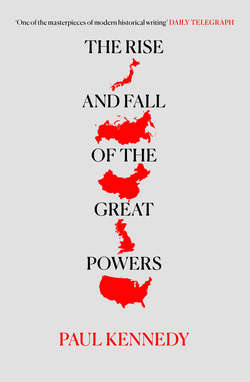The Rise and Fall of the Great Powers

Реклама. ООО «ЛитРес», ИНН: 7719571260.
Оглавление
Paul Kennedy. The Rise and Fall of the Great Powers
COPYRIGHT
PRAISE
DEDICATION
CONTENTS
MAPS
TABLES AND CHARTS. TABLES
CHARTS
INTRODUCTION
1. The Rise of the Western World
Ming China
The Muslim World
Two Outsiders – Japan and Russia
The ‘European Miracle’15
2. The Habsburg Bid for Mastery, 1519–1659
The Meaning and Chronology of the Struggle
Strengths and Weaknesses of the Habsburg Bloc
International Comparisons
War, Money, and the Nation-State
3. Finance, Geography, and the Winning of Wars, 1660–1815
The ‘Financial Revolution’
Geopolitics
The Winning of Wars, 1660–1763
The Winning of Wars, 1763–1815
4. Industrialization and the Shifting Global Balances, 1815–85
The Eclipse of the Non-European World
Britain as Hegemon?
The ‘Middle Powers’
The Crimean War and the Erosion of Russian Power
The United States and the Civil War
The Wars of German Unification
Conclusions
5. The Coming of a Bipolar World and the Crisis of the ‘Middle Powers’: Part One, 1885–1918
The Shifting Balance of World Forces
The Position of the Powers, 1885–1914
ITALY
JAPAN
GERMANY
AUSTRIA-HUNGARY
FRANCE
GREAT BRITAIN
RUSSIA
UNITED STATES
Alliances and the Drift to War, 1890–1914
Total War and the Power Balances, 1914–18
6. The Coming of a Bipolar World and the Crisis of the ‘Middle Powers’: Part Two, 1919–42. The Postwar International Order
The Challengers
FRANCE AND BRITAIN
The Offstage Superpowers
The Unfolding Crisis, 1931–42
7. Stability and Change in a Bipolar World, 1943–80
‘The Proper Application of Overwhelming Force’
The New Strategic Landscape
The Cold War and the Third World
The Fissuring of the Bipolar World
The Changing Economic Balances, 1950–80
8. To the Twenty-first Century. History and Speculation
China’s Balancing Act
The Japanese Dilemma
The EEC – Potential and Problems
The Soviet Union and Its ‘Contradictions’
The United States: the Problem of Number One in Relative Decline
Epilogue
NOTES. 1. The Rise of the Western World
2. The Habsburg Bid for Mastery, 1519–1659
3. Finance, Geography, and the Winning of Wars, 1660–1815
4. Industrialization and the Shifting Global Balances, 1815–85
5. The Coming of a Bipolar World and the Crisis of the ‘Middle Powers’: Part One, 1885–1918
6. The Coming of a Bipolar World and the Crisis of the ‘Middle Powers’: Part Two, 1919–42
7. Stability and Change in a Bipolar World, 1943–80
8. To the Twenty-first Century
Epilogue
FOOTNOTES. Chapter 1
Chapter 2
Chapter 3
Chapter 4
Chapter 5
Chapter 6
Chapter 8
BIBLIOGRAPHY
INDEX
ACKNOWLEDGEMENTS
ABOUT THE AUTHOR
ABOUT THE PUBLISHER
Отрывок из книги
‘The dilemma created by the United States’ relative decline and continuing world-wide military commitments is brilliantly analysed. … Kennedy’s analysis has caught the American imagination because of his ability to interpret both current problems and future trends in an historical perspective stretching back half a millennium to the end of the Middle Ages. … The Rise and Fall of the Great Powers is one of the masterpieces of modern historical writing. It is also a striking vindication of the often neglected truth that the only way to understand the present is to understand the past.’
CHRISTOPHER ANDREW, Daily Telegraph
.....
Two factors, one external, one internal, aided Sweden’s swift growth from these unpromising foundations. The first was foreign entrepreneurs, in particular the Dutch but also Germans and Walloons, for whom Sweden was a promising ‘undeveloped’ land, rich in raw materials such as timber and iron and copper ores. The most famous of these foreign entrepreneurs, Louis de Geer, not only sold finished products to the Swedes and bought the raw ores from them; he also, over time, created timber mills, foundries, and factories, made loans to the king, and drew Sweden into the mercantile ‘world system’ based chiefly upon Amsterdam. Soon the country became the greatest producer of iron and copper in Europe, and these exports brought in the foreign currency which would soon help to pay for the armed forces. In addition, Sweden became self-sufficient in armaments, a rare feat, thanks again to foreign investment and expertise.76
The internal factor was the well-known series of reforms instituted by Gustavus Adolphus and his aides. The courts, the treasury, the tax system, the central administration of the chancery, and education were but some of the areas made more efficient and productive in this period. The nobility was led away from faction into state service. Religious solidarity was assured. Local as well as central government seemed to work. On these firm foundations, Gustavus could build a Swedish navy so as to protect the coasts from Danish and Polish rivals and to ensure the safe passage of Swedish troops across the Baltic. Above all, however, the king’s fame rested upon his great military reforms: in developing the national standing army based upon a form of conscription, in training his troops in new battlefield tactics, in his improvements of the cavalry and introduction of mobile, light artillery, and finally in the discipline and high morale which his leadership gave to the army, Gustavus had at his command perhaps the best fighting force in the world when he moved into northern Germany to aid the Protestant cause during the summer of 1630.77
.....